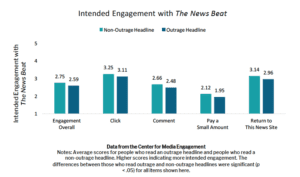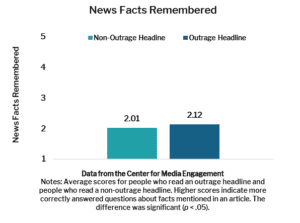
Covering the latest outrageous political story seems like an obvious choice. The digital world is competitive and, bottom line, you need the clicks. But this type of story might not only fail to boost engagement, it could also hurt the credibility of your news organization.
The Center for Media Engagement’s latest research looks at the effects of “outrage news” that focuses on outrageous behavior by political leaders. In a previous study, we found that questions in political news headlines make audiences less likely to engage. Now, we examine how one particular type of political content, outrage news, affects readers.
What is “Outrage News?”
First, let’s look at what “outrage news” means in the context of this study. Outrage news is content that includes behavior like name-calling, exaggeration, extreme partisanship, obscenity, and verbal sparring. Participants in this study were shown articles and headlines that emphasized this type of behavior by politicians. For example, “Fed chair slams critic, says banking regulations tough enough” vs. “Fed chair says banking regulations tough enough.” The first headline demonstrates outrage news. The results of the study showed that there is little commercial benefit and mixed democratic benefit to including outrage content in political news coverage.
Result 1: Decrease Intended Engagement
Thinking that outrage news will lead to clicks and comments doesn’t hold up. In fact, it can backfire. Readers presented with outrage headlines and articles said they were less likely to click or comment on the article, pay for the article, or even return to the news site. By covering the story, you could be turning away readers. In addition, readers exposed to outrage news were less likely to think that the news source understood their concerns and was engaged in their community.
Result 2: A Blow to Credibility
The story might be true, but it won’t stop readers from thinking “fake news.” It turns out that just covering politicians’ outrageous behavior made readers more likely think the news source was “fake news.” Readers presented with outrage content were also less likely to think that the news outlet was as trustworthy, believable, and credible as those who read non-outrage articles.
Result 3: Perceived Incivility
Outrage content is perceived as more uncivil — which looks at how rude, hostile, emotional, agitated, quarrelsome, uncooperative, uncompromising, and exaggerated the news content is perceived to be. In short, this perceived incivility can decrease engagement.
Result 4: Increased Fact Retention
Yes, readers who were exposed to outrage articles and headlines retained more facts from the article. However, and this is big one, covering outrage content can still lead them to think negatively about the news source. Though readers might remember more facts from this type of content, the overall effect (see results 1-3) can still be negative.
Bottom Line for Newsrooms
Don’t be tempted by potential clicks. In an era when politicians are engaging in outrageous behavior, it might be compelling to cover the story. But this research should make you think twice. Turning to this type of content might not only fail to boost clicks and comments, but it could also harm the reputation of your news outlet. You likely won’t get the engagement you were hoping for and you could end up feeding the narrative of “fake news.”
The full report is available here.





